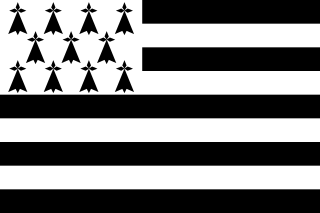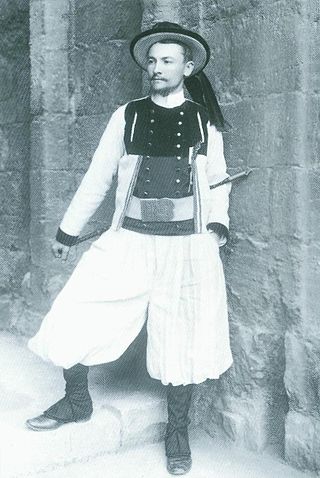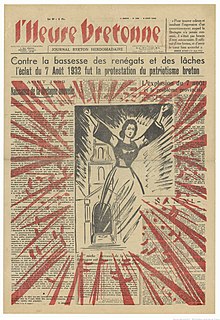
Alan Heusaff, also Alan Heussaff was a Breton nationalist, linguist, dictionary compiler, prolific journalist and lifetime campaigner for solidarity between the Celtic peoples. A co-founder of the Celtic League in 1961, he was its first general secretary until 1984.

Célestin Lainé was a Breton nationalist and collaborator during the Second World War who led the SS affiliated Bezen Perrot militia. His Breton language name is Neven Hénaff. He was a chemical engineer by training. After the war he moved to Ireland.

Breton nationalism is the nationalism of the historical province of Brittany, France. Brittany is considered to be one of the six Celtic nations.

Breiz Atao, was a Breton nationalist journal in the mid-twentieth century. It was written in French, and has always been considered as a French nationalist journal by the non-francized Bretons. The term is also used for the broader movement associated with the journal's political position.
The Breton Social-National Workers' Movement was a nationalist, separatist, and Fascist movement founded in 1941 by Théophile Jeusset. It emerged in Brittany from a deviationist faction of the Breton National Party; it disappeared the same year.

Seiz Breur was an artistic movement founded in 1923 in Brittany. Although it adopted the symbolic name seiz breur, meaning seven brothers in the Breton language, this did not refer to the number of members, but to the title of a folk-story. At its height it had fifty members united as the "Unvaniezh Seiz Breur".

Olier Mordrel is the Breton language version of Olivier Mordrelle, a Breton nationalist and wartime collaborator with the Third Reich who founded the separatist Breton National Party. Before the war, he worked as an architect. His architectural work was influenced by Art Deco and the International style of Le Corbusier. He was also an essayist, short story writer, and translator. Mordrel wrote some of his works under the pen names Jean de La Bénelais, J. La B, Er Gédour, A. Calvez, Otto Mohr, Brython, and Olivier Launay.

Long before World War II, the various Breton nationalist organizations were often anti-French and anti-colonialist, opposed to the Central Government's policy of linguistic imperialism, and critical to varying degrees of post-French Revolution-style Republicanism. Some Breton nationalists were openly pro-fascist. The extent to which this led Breton nationalists into collaboration with the Axis Powers and their motivations, remains a matter of often bitter historical controversy and debate.

The Breton National Party was a nationalist party in Brittany that existed from 1931 to 1944. The party was disbanded after the liberation of France in World War II, because of ties to the Third Reich.

François Debeauvais was a Breton nationalist and wartime collaborator with Nazi Germany. His name is also spelled in many "Breton" variants: François Debauvais, Fransez Debeauvais, Fransez Debauvais, Fañch Debeauvais, Fañch Debauvais, Fañch deb.
The Breton National Committee was a Breton nationalist body founded on July 3, 1940 at the so-called "Congress of Pontivy", headed by François Debeauvais and Olier Mordrel. It was designed to promote Breton independence from France by collaboration with the occupying German forces. They drew up a proclamation of eighteen points, known as "Pontivy Programme". They also created a new journal, l'Heure Bretonne. 201 issues appeared between July 1940 and June 1944. Its first editor was Morvan Lebesque until December 1940, then Jean Merrien.

Morvan Marchal was an architect and a prominent member of the Breton national movement. He is best known for having designed the national flag of Brittany.
René-Yves Creston, born René Pierre Joseph Creston, was a Breton artist, designer and ethnographer who founded the Breton nationalist art movement Seiz Breur. During World War II he was active in the French Resistance.
The Breton Autonomist Party was a political party which existed in Brittany from 1927 to 1931.
Maurice Duhamel was the pen-name of Maurice Bourgeaux, a Breton musician, writer and activist who was a leading figure in Breton nationalism and federalist politics in the years before World War II.
Youenn Drezen is the Breton language name of Yves Le Drézen, a Breton nationalist writer and activist. He is also known as Corentin Cariou and Tin Gariou.

François-Joseph-Claude Jaffrennou was a Breton language writer and editor. He was a Breton nationalist and a neo-druid bard. He is also known as François Taldir-Jaffrennou, since he also used the bardic name Taldir. He was one of the pioneers of the Breton autonomist movement.

The Public Office for the Breton Language was established on 15 October 2010 as a public institution, with state and regional cooperation and funding, to promote and develop teaching and use of the Breton language in daily life. It is an example of language revival efforts for minority languages in France.

François Eliès, born Fañch Eliès and better known by the pseudonym Abeozen, was a Breton nationalist, novelist and dramatist who wrote in the Breton language. Abeozen was also a noted scholar of the Welsh language.

Joseph-Marie Jaffré, better known as Job Jaffré, was a French journalist and Breton nationalist. He also published under pseudonyms, most notably as Jos Pempoull.













